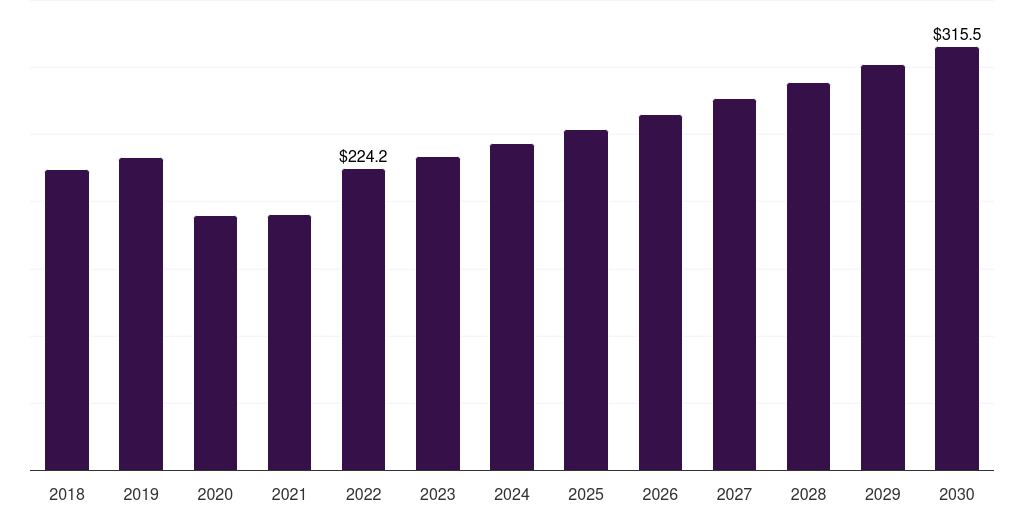Brazil Burn Care Centers Market Size & Outlook, 2022-2030
Brazil burn care centers market, 2018-2030 (US$M)

Related Markets
Brazil burn care centers market highlights
- The Brazil burn care centers market generated a revenue of USD 224.2 million in 2022 and is expected to reach USD 315.5 million by 2030.
- The Brazil market is expected to grow at a CAGR of 4.4% from 2023 to 2030.
- In terms of segment, in-hospital was the largest revenue generating facility type in 2022.
- Standalone is the most lucrative facility type segment registering the fastest growth during the forecast period.
Burn care centers market data book summary
| Market revenue in 2022 | USD 224.2 million |
| Market revenue in 2030 | USD 315.5 million |
| Growth rate | 4.4% (CAGR from 2022 to 2030) |
| Largest segment | In-hospital |
| Fastest growing segment | Standalone |
| Historical data | 2018 - 2021 |
| Base year | 2022 |
| Forecast period | 2023 - 2030 |
| Quantitative units | Revenue in USD million |
| Market segmentation | In-Hospital, Standalone |
| Key market players worldwide | Temple University Hospital, Parkland Hospital, MedStar Health, UMC, Burn and Reconstructive Centers of America, Massachusetts General Hospital, University of Rochester Medical Center, Chelsea and Westminster Hospital, SBH Health System, National Burns Center |
Other key industry trends
- In terms of revenue, Brazil accounted for 1.0% of the global burn care centers market in 2022.
- Country-wise, U.S. is expected to lead the global market in terms of revenue in 2030.
- In Latin America, Brazil burn care centers market is projected to lead the regional market in terms of revenue in 2030.
- Argentina is the fastest growing regional market in Latin America and is projected to reach USD 82.4 million by 2030.
No credit card required*
Horizon in a snapshot
- 30K+ Global Market Reports
- 120K+ Country Reports
- 1.2M+ Market Statistics
- 200K+ Company Profiles
- Industry insights and more
Burn Care Centers Market Scope
Burn Care Centers Market Companies
| Name | Profile | # Employees | HQ | Website |
|---|
Brazil burn care centers market outlook
The databook is designed to serve as a comprehensive guide to navigating this sector. The databook focuses on market statistics denoted in the form of revenue and y-o-y growth and CAGR across the globe and regions. A detailed competitive and opportunity analyses related to burn care centers market will help companies and investors design strategic landscapes.
In-hospital was the largest segment with a revenue share of 62.4% in 2022. Horizon Databook has segmented the Brazil burn care centers market based on in-hospital, standalone covering the revenue growth of each sub-segment from 2018 to 2030.
Increase in health challenges due to burn accidents and injuries is making the population of Brazil more susceptible to infections, disabilities, disfigurements, and death. According to studies, fire-related injuries accounted for 10 million DALYs lost worldwide. Owing to the complexity of the procedures and the need for multidisciplinary teams, the treatment costs are high.
According to the National Library of Medicine article on burns in the Brazilian health system, the mean hospital admission cost in Brazil is USD 856.0, and the mean daily ICU cost was USD 1,330.5. Furthermore, the incidence of hospital admissions due to burn accidents in Brazil in 2017 was 8.94 admissions per 10,000 individuals.
Public and private players in the market are adopting updated wound care & surgical techniques and the government is focusing on enhancing the infrastructure & equipping burn care facilities. For example, in March 2017, Brazilian healthcare providers began using tilapia fish skin for treating severe burns. Tilapia skin accelerates the healing process and minimizes the demand for wound & pain management.
Reasons to subscribe to Brazil burn care centers market databook:
-
Access to comprehensive data: Horizon Databook provides over 1 million market statistics and 20,000+ reports, offering extensive coverage across various industries and regions.
-
Informed decision making: Subscribers gain insights into market trends, customer preferences, and competitor strategies, empowering informed business decisions.
-
Cost-Effective solution: It's recognized as the world's most cost-effective market research database, offering high ROI through its vast repository of data and reports.
-
Customizable reports: Tailored reports and analytics allow companies to drill down into specific markets, demographics, or product segments, adapting to unique business needs.
-
Strategic advantage: By staying updated with the latest market intelligence, companies can stay ahead of competitors, anticipate industry shifts, and capitalize on emerging opportunities.
Target buyers of Brazil burn care centers market databook
-
Our clientele includes a mix of burn care centers market companies, investment firms, advisory firms & academic institutions.
-
30% of our revenue is generated working with investment firms and helping them identify viable opportunity areas.
-
Approximately 65% of our revenue is generated working with competitive intelligence & market intelligence teams of market participants (manufacturers, service providers, etc.).
-
The rest of the revenue is generated working with academic and research not-for-profit institutes. We do our bit of pro-bono by working with these institutions at subsidized rates.
Horizon Databook provides a detailed overview of country-level data and insights on the Brazil burn care centers market , including forecasts for subscribers. This country databook contains high-level insights into Brazil burn care centers market from 2018 to 2030, including revenue numbers, major trends, and company profiles.
Partial client list
Brazil burn care centers market size, by facility type, 2018-2030 (US$M)
Brazil Burn Care Centers Market Outlook Share, 2022 & 2030 (US$M)
Related regional statistics
No records
No related regions found.
Sign up - it's easy, and free!
Sign up and get instant basic access to databook, upgrade
when ready, or enjoy our
free plan indefinitely.
Included in Horizon account
- 30K+ Global Market Reports
- 120K+ Country Reports
- 1.2M+ Market Statistics
- 200K+ Company Profiles
- Industry insights and more



